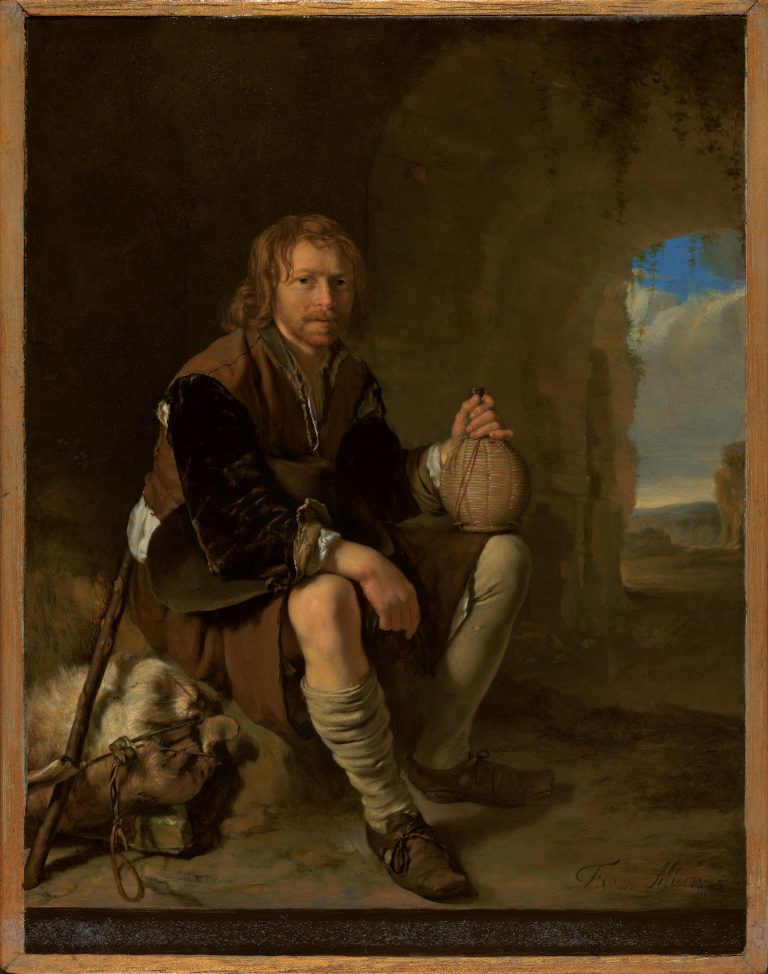Traveler at Rest, datable to about 1657, is one of Frans van Mieris’s earliest masterpieces.1 Beautifully executed and wonderfully preserved, this painting demonstrates why this Leiden master was famous for his ability to render light effects and the varied textures of materials. Van Mieris has here depicted a young, red-haired man sitting in the shade of ancient ruins partly overgrown with vegetation and gazing straight at the viewer. In his lap lies a rather large hat, and in his left hand he holds a flask with a wicker cover. Judging from the bag lying beside him, his walking stick, sagging stocking and the torn seam at his shoulder, the man has been traveling and has stopped in a cool spot to refresh himself. The landscape beyond the ruin’s arched opening is reminiscent of the sun-drenched images of the Dutch Italianates, whose paintings must have served as Van Mieris’s source of inspiration, since he never traveled to Italy.2
Van Mieris painted a similar composition, but in reverse, on the easel in the interior of his The Painter in His Studio of about 1657 in the Staatliche Kunstsammlungen, Dresden (fig 1). In that scene, a wealthy visitor or connoisseur studies the painting closely under the artist’s watchful eye. There, too, the painting on the easel features a man with a walking stick seated in a relaxed manner under the arched vault of an antique ruin (fig 2). He has removed a sock and a shoe to cool off and rest after his travels. In much the same manner, the sagging stocking in the Leiden Collection painting indicates that the traveler is at rest.3 Van Mieris emphasizes the traveler’s bared knee by having the young man rest his arm on it, a pose also seen in a depiction of a smoking man by Simon Kick (1603–52) and in Carel Fabritius’s (1622–54) Sentry from 1654 (Schwerin, Staatliches Museum).4 In each of these instances this motif indicates that the man is resting his tired feet.5
The clothing of the man depicted in Traveler at Rest denotes a certain affluence, and he may very well have been a Dutchman who went to Italy and wanted to have his trip commemorated once he had returned to Leiden. The man’s face, which has all the striking features of an actual portrait, closely resembles that of the visitor in Van Mieris’s Dresden painting, who seems to have come to the artist’s studio to see how he has been represented. The tattered look, the direct gaze, and the Italianate setting in the Leiden Collection painting similarly indicate that the sitter wanted to stress his full engagement in the experience of being abroad.6 The directness of the portrait resembles that of cloth merchant Anthony de Bordes, who commissioned a portrait by Michael Sweerts (1618–64) in about 1648 (fig 3). De Bordes visited Italy in 1648, and the backdrop of his portrait—an obelisk standing in a park-like landscape with a fountain—places the scene in Rome.7 Whereas the merchant is helped out of his boots by a servant, suggesting he has just returned from riding in the Roman countryside, the man in Van Mieris’s painting has simply been walking.
In painting Traveler at Rest, Van Mieris used a copper plate, an ultra-smooth support ideally suited to his refined and meticulous technique.8 Interestingly, the artist, who had spent a short time training as a goldsmith, applied a layer of gold leaf over the copper ground.9 Rembrandt had done the same around 1629–30 in his Laughing Soldier.10 But while the latter artist allowed the gold to glint through the surface of the paint, Van Mieris covered up the gold with his preparatory layers. He may have wanted to protect the painting from the ravages of time, as gold shields the paint from copper’s oxidation. In any event, this expensive technique is another indication that the painting was commissioned by a wealthy individual who wanted his portrait painted as a reminder of his travels to Italy. Without knowing the details of Van Mieris’s technique, Gustav Friedrich Waagen (1797–1868), the director of the Berlin museums and the first professor of art history in that city, praised this painting in 1854 as being “of that soft golden tone, and of that delicate feeling, which distinguish his best pictures.”11
The earliest known owner of Traveler at Rest is probably Jacob Hoofman (d. 1799). After his death, the painting must have been inherited by one of his art-loving daughters, either Margaretha Hoofman (1773–1807) or Maria Hoofman (1776–1845), who each inherited half of their father’s collection.12 After Margaretha’s death, her part of the paintings collection was inherited by her husband, Pieter Quarles van Ufford (1757–1834), who transferred the ownership of the most important works in this collection to his unmarried sister-in-law, Maria Hoofman, while others were sold anonymously in 1818.13 In or before 1819 the painting was part of the art collection of shipbuilder William Wells (1768–1847), who lived in Kent.14 After Wells’s death, the painting was acquired by Robert Staynor Holford (1808–92), a member of the British parliament. In 1857 Holford lent the painting to the famous exhibition in Manchester, Art Treasures of the United Kingdom.15 Apart from that exhibition, the painting remained at Holford’s London residence, Dorchester House, which his son, Sir George Holford (1860–1926), inherited in 1892. After the latter’s death, Traveler at Rest became the property of Giovanni Agnelli (1921–2003), head of the Italian automobile company Fiat in Turin. The painting entered a private collection in Germany in 1988, after which it was acquired by the New York collector Eric Martin Wunsch (1924–2013). In January 2014, this exquisite painting entered the Leiden Collection.
